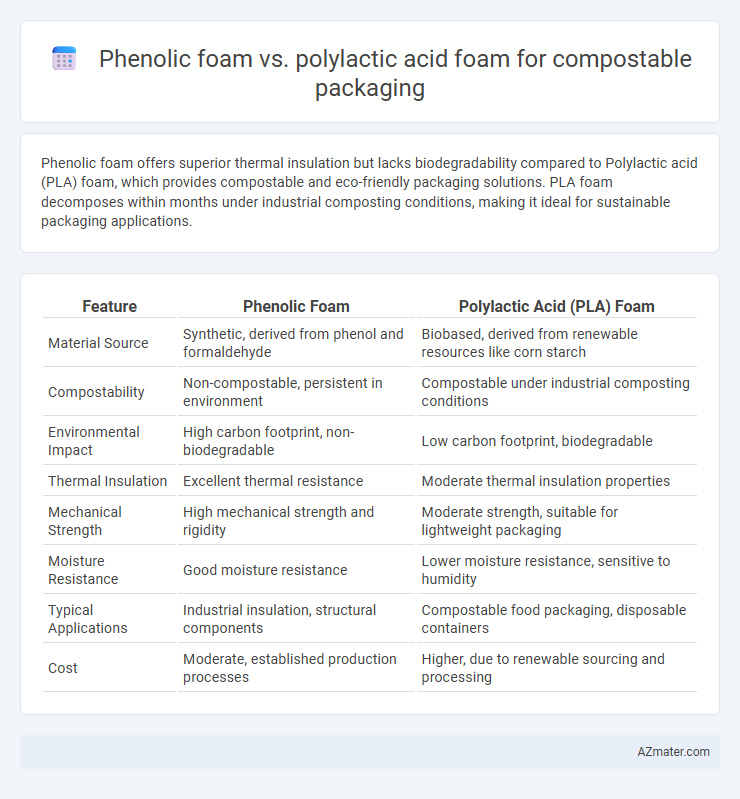Phenolic foam offers superior thermal insulation but lacks biodegradability compared to Polylactic acid (PLA) foam, which provides compostable and eco-friendly packaging solutions. PLA foam decomposes within months under industrial composting conditions, making it ideal for sustainable packaging applications.
Table of Comparison
| Feature | Phenolic Foam | Polylactic Acid (PLA) Foam |
|---|---|---|
| Material Source | Synthetic, derived from phenol and formaldehyde | Biobased, derived from renewable resources like corn starch |
| Compostability | Non-compostable, persistent in environment | Compostable under industrial composting conditions |
| Environmental Impact | High carbon footprint, non-biodegradable | Low carbon footprint, biodegradable |
| Thermal Insulation | Excellent thermal resistance | Moderate thermal insulation properties |
| Mechanical Strength | High mechanical strength and rigidity | Moderate strength, suitable for lightweight packaging |
| Moisture Resistance | Good moisture resistance | Lower moisture resistance, sensitive to humidity |
| Typical Applications | Industrial insulation, structural components | Compostable food packaging, disposable containers |
| Cost | Moderate, established production processes | Higher, due to renewable sourcing and processing |
Introduction to Compostable Packaging Materials
Compostable packaging materials such as phenolic foam and polylactic acid (PLA) foam offer eco-friendly alternatives designed to reduce environmental impact by breaking down naturally under composting conditions. Phenolic foam, derived from synthetic resins, provides excellent thermal insulation and durability but has limited compostability compared to PLA, a biopolymer made from renewable plant sugars that fully degrades in industrial composting environments. Selecting the appropriate compostable foam depends on balancing performance requirements with biodegradability standards established by certifications like ASTM D6400 or EN 13432.
Overview of Phenolic Foam: Properties and Applications
Phenolic foam exhibits exceptional thermal insulation, fire resistance, and dimensional stability, making it a preferred choice for high-performance insulation and protective packaging applications. Its rigid structure, low smoke emission, and chemical resistance contribute to durability in harsh environments and prolonged shelf life for sensitive goods. Although not inherently compostable, advancements in bio-based phenolic resins are enhancing its sustainability profile for eco-friendly packaging solutions.
Understanding Polylactic Acid (PLA) Foam
Polylactic Acid (PLA) foam, derived from renewable resources like corn starch, offers a biodegradable and compostable alternative to traditional phenolic foam, which is petroleum-based and non-degradable. PLA foam features excellent thermal insulation and cushioning properties, making it ideal for sustainable packaging applications that require environmental responsibility. Its compostability within industrial facilities ensures reduced landfill waste while supporting circular economy practices in packaging industries.
Environmental Impact: Phenolic Foam vs PLA Foam
Phenolic foam is derived from petrochemical sources, resulting in a longer degradation time and potential release of toxic residues, whereas polylactic acid (PLA) foam is bio-based and compostable within industrial composting facilities, leading to significantly reduced environmental impact. PLA foam breaks down into carbon dioxide, water, and biomass under controlled composting conditions, contributing to lower landfill waste and greenhouse gas emissions. In contrast, phenolic foam's persistence in the environment and challenges in recycling hinder its sustainability profile compared to PLA foam's renewable origin and biodegradable properties.
Performance and Durability Comparison
Phenolic foam offers superior thermal insulation and fire resistance but is less biodegradable compared to polylactic acid (PLA) foam, which excels in compostability and environmental friendliness. PLA foam provides adequate cushioning and moisture resistance suitable for short-term packaging but lacks the long-term durability and mechanical strength found in phenolic foam. For compostable packaging, PLA foam balances performance with eco-friendly degradation, while phenolic foam is preferred for applications demanding higher durability and heat resistance despite its limited compostability.
Biodegradability and Compostability Analysis
Phenolic foam exhibits limited biodegradability due to its synthetic resin matrix, resulting in poor compostability and environmental persistence in composting systems. Polylactic acid (PLA) foam, derived from renewable biomass sources, demonstrates superior biodegradability and readily decomposes under industrial composting conditions within 90 to 180 days. Life cycle assessment studies confirm PLA foam's compatibility with municipal compost facilities, making it a more sustainable choice for compostable packaging applications.
Cost Considerations in Packaging Solutions
Phenolic foam typically incurs higher production costs due to its complex chemical synthesis and processing requirements, making it less economically viable for large-scale compostable packaging. Polylactic acid (PLA) foam offers a cost advantage as it is derived from renewable resources like corn starch, with manufacturing processes that are increasingly optimized and scalable, reducing overall expenses. The cost-effectiveness of PLA foam aligns with growing demand for sustainable packaging, driving wider adoption despite initial raw material price fluctuations.
Safety and Health Implications
Phenolic foam, derived from synthetic resins, poses potential health risks due to formaldehyde emissions and limited biodegradability, making it less suitable for compostable packaging. Polylactic acid (PLA) foam, sourced from renewable biomass like corn starch, offers safer and non-toxic compostable properties, minimizing environmental and human health hazards. The biodegradability and non-toxic profile of PLA foam significantly reduce risks associated with chemical leaching and exposure compared to phenolic foam.
Market Trends and Future Outlook
Phenolic foam faces limited growth in compostable packaging due to its synthetic origin and challenging biodegradability, while polylactic acid (PLA) foam shows rapid market expansion driven by increasing demand for sustainable, bio-based materials. PLA foam's enhanced compostability, coupled with supportive regulatory frameworks and consumer preference for eco-friendly packaging, positions it as a key player in the future market landscape. Innovations in PLA foam production and cost reduction are expected to further accelerate adoption, outpacing phenolic foam in compostable packaging applications.
Conclusion: Choosing the Right Foam for Sustainable Packaging
Phenolic foam offers excellent thermal insulation and fire resistance but is less biodegradable, making it less suitable for fully compostable packaging solutions. Polylactic acid (PLA) foam, derived from renewable resources like corn starch, provides compostability and eco-friendly disposal benefits, aligning well with sustainable packaging goals. Selecting PLA foam supports circular economy practices by ensuring the packaging breaks down efficiently in industrial composting environments.

Infographic: Phenolic foam vs Polylactic acid foam for Compostable packaging
 azmater.com
azmater.com